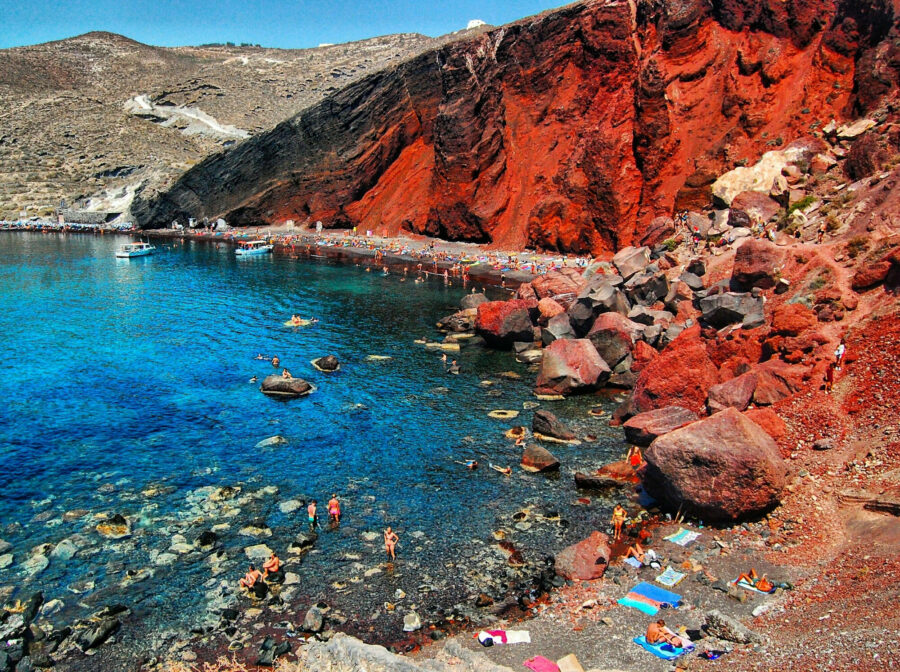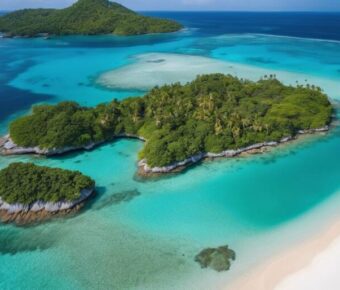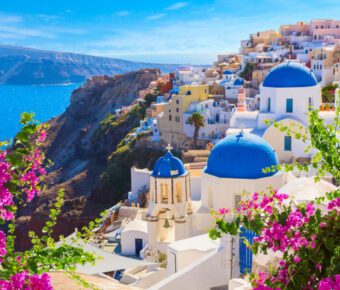
Dubrovnik vs Santorini: Epic Battle of Mediterranean’s Most Enchanting Coastal Cities
Planning a Mediterranean getaway can be tricky when choosing between two stunning coastal destinations. Dubrovnik and Santorini each offer unique experiences that appeal to different types of travelers. While Dubrovnik enchants visitors with its medieval walls and red-roofed buildings along the Adriatic Sea, Santorini captivates with its white-washed villages perched on dramatic cliffs.
Most travelers spend 3-7 days in Santorini to explore its volcanic beaches and famous sunsets, while 1-5 days is ideal for discovering Dubrovnik’s historic sites and nearby islands. Families tend to prefer Dubrovnik’s mix of beaches, boat trips, and cultural attractions. The Croatian city also offers more space to move around compared to Santorini’s narrow clifftop paths.
Both destinations get busy with cruise ships during peak season, but each maintains its distinct charm. Dubrovnik shines with its preserved architecture and crystal-clear waters, perfect for swimming and island hopping. Santorini stands out for its iconic blue-domed churches and unique black sand beaches shaped by volcanic activity.
Contents
- Geographical Location and Accessibility
- Getting to Dubrovnik
- Getting to Santorini
- Historical Significance
- Dubrovnik’s Rich Past
- Santorini’s Ancient Allure
- Climate and Best Time to Visit
- Dubrovnik’s Weather Patterns
- Santorini’s Seasonal Climates
- Landscape and Natural Beauty
- Dubrovnik’s Coastal Charm
- Santorini’s Volcanic Vistas
- Cultural Experience
- Living Like a Local in Dubrovnik
- Embracing Greek Traditions in Santorini
- Accommodations and Amenities
- Staying in Dubrovnik
- Finding a Place in Santorini
- Unique Attractions and Activities
- Dubrovnik’s Distinctive Offerings
- Santorini Beyond the Sunsets
- Culinary Delights and Dining
- Taste of Dubrovnik
- Savoring Santorini
- Frequently Asked Questions
- What are the top tourist attractions in Dubrovnik and Santorini?
- How does the local cuisine of Dubrovnik compare to that of Santorini?
- What are the differences in climate between Dubrovnik and Santorini throughout the year?
- Which destination offers better options for accommodations, Dubrovnik or Santorini?
- How do the historical and cultural experiences differ between Dubrovnik and Santorini?
- Can you compare the beaches of Dubrovnik with those of Santorini in terms of scenic beauty and facilities?
- More Travel Guides
Geographical Location and Accessibility
Both destinations sit along the stunning Mediterranean coastline, with distinct locations that shape their charm and travel logistics. Santorini floats in the Aegean Sea while Dubrovnik hugs the Adriatic coast.
Getting to Dubrovnik

Dubrovnik sits on Croatia’s southern Dalmatian coast, making it easy to reach by air, sea, or land. The city’s airport welcomes direct flights from many European cities through major airlines and travel sites.
You can drive to Dubrovnik from other Croatian cities via coastal roads with amazing sea views. The drive from Split takes about 4 hours.
Ferry connections link Dubrovnik to several Italian ports across the Adriatic Sea. The main port sits just 3 km from the Old Town.
Buses run regularly between Dubrovnik and other Croatian cities, plus Montenegro and Bosnia.
Getting to Santorini

Santorini lies 200 kilometers southeast of mainland Greece in the Cyclades island group. The island’s airport handles direct flights from Athens and many European cities during peak season.
The most common way to reach Santorini is by ferry from Athens’ Piraeus port. Fast ferries take 5 hours while regular ones need 8 hours.
You can book flights and ferries year-round, but options increase a lot from April to October.
Island hopping to nearby Greek islands like Ios and Mykonos is simple with frequent ferry service from Santorini’s port.
Historical Significance
Both ancient Mediterranean cities hold fascinating stories spanning thousands of years, shaped by seafaring trade, cultural exchanges, and dramatic natural events.
Dubrovnik’s Rich Past

The story of Dubrovnik began in the 7th century as a small settlement called Ragusa. Greek settlers picked this rocky spot on the Adriatic coast, seeing its potential as a protected harbor. The city grew into a powerful maritime republic during the Middle Ages.
Dubrovnik reached its peak in the 14th and 15th centuries. The city-state built massive stone walls and fortifications that still stand today. These walls protected its independence and wealth from rival powers.
Trade made Dubrovnik rich. Ships from its port sailed across the Mediterranean, dealing in salt, silver, and fine textiles. The city’s merchants established trading posts from Italy to Constantinople.
Santorini’s Ancient Allure

Santorini’s history stretches back to the Minoan civilization around 3,600 years ago. The island was home to Akrotiri, an advanced Bronze Age settlement frozen in time by a massive volcanic eruption.
This eruption changed Santorini forever. It created the iconic caldera and cliffs that define the island today. The event may have inspired the legend of lost Atlantis.
Ancient Greek colonists settled here in the 9th century BC. They built the city of Ancient Thera on a mountain ridge. Its ruins show temples, houses, and public buildings that reveal daily life in the Classical world.
The island’s volcanic soil proved perfect for growing grapes. Wine production became a key part of Santorini’s economy and culture, a tradition that continues today.
Climate and Best Time to Visit
The Mediterranean climate shapes both destinations, with hot summers and mild winters creating distinct travel seasons. Peak temperatures hit in July and August, when crowds pack the streets and beaches.
Dubrovnik’s Weather Patterns

Dubrovnik enjoys warm, sunny days from May through September. Summer temperatures climb to 27°C (81°F), perfect for swimming and exploring the city walls. The mid-day sun can be intense, so morning walks are best.
Spring brings pleasant days around 20°C (68°F) with fewer tourists. The sea stays warm enough for swimming into October. Winter temperatures rarely drop below 10°C (50°F).
July and August see the biggest crowds and highest prices. May and September offer great weather without peak season chaos. These shoulder months let you enjoy outdoor cafes and beaches in comfort.
Santorini’s Seasonal Climates

The Greek island basks in sunshine nearly 300 days per year. Summer temperatures reach 29°C (84°F), and the famous white buildings reflect the strong mid-day sun. Morning tours of the caldera are smart to beat the heat.
Beach weather starts in May and stretches into October. The winds called “meltemi” bring relief from July-August heat but can kick up sand on beaches.
Winter stays mild at 15°C (59°F) but brings more rain and closed tourist spots. April-May and September-October hit the sweet spot – warm days, open attractions, and smaller crowds than peak summer.
Swimming and sunset views shine from June through September. The sea temperature peaks at 25°C (77°F) in August.
Landscape and Natural Beauty
Dramatic coastal landscapes define these Mediterranean destinations, with Dubrovnik’s limestone cliffs meeting the blue Adriatic and Santorini’s volcanic caldera creating a stunning natural amphitheater above the sea.
Dubrovnik’s Coastal Charm

Limestone cliffs drop straight into the crystal-clear Adriatic Sea, creating a stunning backdrop for Dubrovnik’s medieval walls. The coastline features hidden coves and pebbly beaches nestled between rocky outcrops.
Banje Beach sits just outside the city walls, offering picture-perfect views of the old town’s terracotta roofs. The water here sparkles in shades of turquoise and azure.
The nearby Lokrum Island adds to the natural scenery with its dense Mediterranean vegetation and peaceful rocky shores. Pine trees and native plants cover the surrounding hillsides, creating a lush green frame around the stone city.
Santorini’s Volcanic Vistas

The island’s crescent shape comes from an ancient volcanic eruption that left behind towering red and black cliffs rising 300 meters above the sea. These dramatic caldera walls create some of the most photographed views in Greece.
The volcanic history gave Santorini unique black sand beaches like Perissa and Kamari. Red Beach stands out with its rust-colored cliffs and dark sand.
The island’s famous sunsets paint the white villages in golden light each evening. From high points in Oia or Imerovigli, you can see the volcanic islands of Nea Kameni and Palea Kameni sitting in the caldera’s center.
Natural hot springs bubble up near the volcano, tinting the sea waters with mineral-rich colors. The lunar-like landscape reveals layers of volcanic rock in striking reds, whites and blacks.
Cultural Experience
Both destinations offer rich traditions and authentic ways to experience Mediterranean life through food, customs, and daily routines.
Living Like a Local in Dubrovnik

The walled city buzzes with local life beyond the tourist spots. Early mornings bring fishermen selling fresh catches at the harbor markets. Locals gather at small cafes to sip strong Croatian coffee and nibble on burek pastries.
Traditional klapa singing echoes through narrow streets during summer evenings. This a cappella style tells stories of love and life by the sea. Street musicians often join in with mandolins and guitars.
Croatian cooking classes teach visitors to make black risotto and fresh seafood dishes. Many families open their homes for authentic dining experiences called “home restaurants.”
Embracing Greek Traditions in Santorini

Blue-domed churches mark special festivals where locals dance traditional syrtos and celebrate saints’ days. The sound of bouzouki music fills tavernas as plates of mezedes appear on tables.
Greek families welcome guests to help prepare classic dishes like moussaka and tzatziki. Vineyard tours show ancient wine-making methods still used today. Local yiayias (grandmothers) teach visitors to roll grape leaves for dolmades.
Small village festivals called panigiria bring communities together with food, wine, and dancing under the stars. Fishing boats still use traditional methods to catch the day’s offerings for seaside tavernas.
The island’s unique volcanic soil creates distinct flavors in local products like fava beans, white eggplants, and cherry tomatoes. Food markets showcase these ingredients alongside fresh-made cheeses and olives.
Accommodations and Amenities
Both cities offer distinct lodging options that match their unique character and layout. The choice between staying in historic centers or quiet outskirts can make a big difference in your experience.
Staying in Dubrovnik

Most hotels in Dubrovnik sit either within the ancient walls or along the gorgeous coastline. Lapad and Babin Kuk areas feature large resort-style properties perfect for families with pools and beach access.
Small boutique hotels tucked into the Old Town provide a more intimate experience. These spots put you steps from landmarks but mean dealing with lots of stairs and crowds during peak season.
Apartments and villas outside the walls give you more space and often include parking. Many travelers pick these to avoid the tourist crush while still staying close to attractions.
Finding a Place in Santorini

The iconic hotels and accommodations in Oia offer those classic caldera views but come with premium prices. Cave houses carved into the cliffs provide unique stays with private terraces.
Parking in Oia is very limited, so properties outside town work better for travelers with rental cars. These spots often include free parking and shuttle service to main areas.
Traditional villages like Imerovigli and Firostefani provide similar views at lower prices than Oia. Many properties here feature private pools and more peaceful surroundings.
Small family-run guesthouses in inland villages give you an authentic Greek experience. These spots cost less and put you closer to local life.
Unique Attractions and Activities
Both Mediterranean destinations boast spectacular landmarks and exciting activities that set them apart. From ancient fortifications to volcanic landscapes, each place has distinct experiences that make them special.
Dubrovnik’s Distinctive Offerings

The UNESCO-listed Old City walls stand as Dubrovnik’s most iconic feature. These massive stone fortifications offer breathtaking walks with views of terracotta roofs and the sparkling Adriatic Sea below.
Hidden within the limestone streets, visitors find unique museums like the War Photo Limited gallery and the quirky Red History Museum. These spaces tell important stories about the region’s past.
Book guided walking tours to discover secret spots in the walled city. Local guides share tales of medieval life and point out Game of Thrones filming locations.
Sea kayaking trips around Lokrum Island let adventurers explore sea caves and secluded beaches. The nearby Elafiti Islands make perfect day trips for swimming and snorkeling.
Santorini Beyond the Sunsets

The island’s volcanic history created stunning black and red sand beaches. Perissa Beach offers dramatic dark shores against white cliffs.
Ancient Akrotiri reveals a preserved Minoan settlement buried by volcanic ash. This archaeological site gives glimpses into life before the massive eruption that shaped modern Santorini.
Visitors can hike from Fira to Oia along the caldera’s edge. The trail provides incredible views of the volcano and whitewashed villages clinging to cliff sides.
Wine tasting experiences showcase unique volcanic varietals at traditional wineries. The mineral-rich soil produces distinctive assyrtiko grapes used in crisp local wines.
Boat trips to the volcano let travelers climb to smoking craters and swim in hot springs. Sunset cruises around the caldera offer new perspectives of the island’s rugged beauty.
Culinary Delights and Dining
Both destinations offer incredible Mediterranean flavors with their own unique local specialties. Each city serves up fresh seafood, local wines, and traditional dishes that reflect their rich cultural heritage.
Taste of Dubrovnik

The food scene in Dubrovnik combines Adriatic and Mediterranean influences. Fresh seafood stands out as a local favorite, with grilled fish and black risotto appearing on many menus.
Traditional peka dishes deserve special attention – meat or seafood slow-cooked under a bell-shaped lid with vegetables and herbs. The flavors are incredible.
Local restaurants serve hearty plates of handmade pasta, often paired with seafood or meat sauces. The pasta recipes have been passed down through generations.
Street food in Dubrovnik offers quick, tasty bites. Try burek (cheese or meat-filled pastries) from small bakeries throughout the old town.
Savoring Santorini

Santorini’s cuisine features fresh ingredients grown in volcanic soil. The island’s white eggplants have a sweet, delicate flavor that makes them special.
Must-try local specialties:
- Fava (yellow split pea puree)
- Fresh grilled fish
- Cherry tomatoes
- Local white wines
- Moussaka topped with rich béchamel
Greek mezedes (small plates) let you sample many flavors at once. Tzatziki, feta cheese, and crispy calamari are popular choices.
The sunset views make dining extra special. Many restaurants offer terraces overlooking the caldera while serving traditional Greek dishes with modern twists.
Frequently Asked Questions
Travel choices between Dubrovnik and Santorini come with many specific details to consider. These destinations each offer distinct experiences in terms of attractions, food, weather, and accommodations.
What are the top tourist attractions in Dubrovnik and Santorini?
Dubrovnik’s famous City Walls stretch 2 kilometers around the Old Town. The walls offer amazing views of red-tiled roofs and the blue Adriatic Sea.
The nearby Lokrum Island makes a perfect day trip from Dubrovnik. Visitors can swim, hike, or explore the botanical gardens.
Santorini’s blue-domed churches in Oia are among the most photographed spots in Greece. The white buildings against the deep blue sea create picture-perfect views.
The ancient ruins of Akrotiri showcase life before the volcanic eruption that shaped Santorini. The site features well-preserved frescoes and pottery from 1627 BCE.
How does the local cuisine of Dubrovnik compare to that of Santorini?
Dubrovnik’s cuisine focuses on fresh seafood and Mediterranean ingredients. Local specialties include black risotto made with cuttlefish ink and grilled fish with Swiss chard.
Santorini offers unique local ingredients like white eggplants and cherry tomatoes that grow in volcanic soil. The island’s fava (yellow split pea puree) and fresh grilled octopus are must-try dishes.
Traditional tavernas in both places serve authentic meals at reasonable prices. Each location takes pride in its local wine production.
What are the differences in climate between Dubrovnik and Santorini throughout the year?
Dubrovnik enjoys hot summers with temperatures around 85°F (29°C) and mild winters near 50°F (10°C). The water stays warm enough for swimming from May to October.
Santorini experiences slightly warmer temperatures year-round. Summers reach 90°F (32°C), while winters stay mild at 55°F (13°C).
Both places get crowded in July and August. May, June, September, and October offer nice weather with fewer tourists.
Which destination offers better options for accommodations, Dubrovnik or Santorini?
Dubrovnik features a mix of modern hotels and private apartments. Staying inside the Old Town walls costs more but puts visitors close to main attractions.
Many Sobe (private rooms) in Dubrovnik provide affordable options with local charm. These often include kitchen access and helpful hosts.
Santorini specializes in cave hotels built into the caldera cliffs. These unique rooms offer stunning sunset views but come at premium prices.
Budget options exist in both places away from prime areas. Staying in Perissa (Santorini) or Lapad (Dubrovnik) saves money while maintaining good beach access.
How do the historical and cultural experiences differ between Dubrovnik and Santorini?
Dubrovnik’s history centers on its role as a medieval maritime republic. The Gothic and Baroque churches, monasteries, and palaces tell stories of wealth and trade.
The Game of Thrones filming locations draw fans to Dubrovnik. Many tours combine show locations with real historical sites.
Santorini’s history goes back to ancient times. The Minoan settlement at Akrotiri shows advanced civilization from 3,000 years ago.
Greek Orthodox churches dot Santorini’s landscape. Local customs and festivals keep traditional culture alive.
Can you compare the beaches of Dubrovnik with those of Santorini in terms of scenic beauty and facilities?
Dubrovnik’s beaches feature pebbles and clear blue water. Banje Beach sits right outside the Old Town walls and rents chairs and umbrellas.
Several beach clubs near Dubrovnik offer pools and fancy amenities. Copacabana Beach provides water sports and restaurant service.
Santorini’s Red Beach stands out with dramatic red cliffs. The black sand beaches of Perissa and Kamari stretch for kilometers.
Most Santorini beaches offer organized sections with sunbeds. Beach bars and tavernas line the shore at popular spots.



